
copyright 2009 by George Johnson

Safford, Arizona. photos by George Johnson, copyright 2009
1. Retrofit Arithmetic (and Rainbarrel Economics)
2. The San Juan-Chama Shell Game
3. The Case of the Disappearing Aquifer
4. The Creative Hydrology of Suerte del Sur
5. The City, the County, and a Water Tax Revolt
6. Water Numerology at City Hall
(Our story thus far)
7. The Woman at Otowi Gauge
8. "Forget it, Jake. It's Chinatown."
9. The Las Campanas Connection
(Our story continues)
10. The Engineering Solution
February 25, 2009
58. Updates from the Battle Fronts
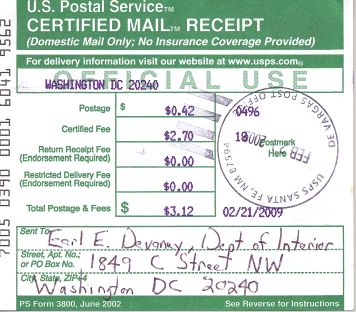
It has been exactly five months since I wrote to Stephen Hardgrove, the assistant inspector general in charge of investigations at the Department of Interior, to ask how the All Indian Pueblo Council got away with bulldozing the historically protected campus of the Santa Fe Indian School. (For those new to the story please see A Special Report: The Mysterious Destruction of the Santa Fe Indian School.) I never received an answer or even an acknowledgment of the letter. But with a new Interior Secretary in office I have decided to try again. This time I've written to Inspector General Earl Devaney, Mr. Hardgrove's boss, and sent a copy of the letter to Senator Tom Udall, a member of the Indian Affairs Committee.
I seem to have gotten a reaction. The way I have configured my web server, I can type "acc" (for "access") into a Unix terminal and instantly see a list of Internet addresses for the last 50 visitors to this site. (Fear not for your privacy: It is not possible to identify individuals -- only to see that one of the many computers served by Comcast, Qwest, or some other entity has dropped by.) This afternoon I started getting hits from the Bureau of Indian Affairs, and a whole slew of them from the U.S. Senate.
There are other matters to catch up on for this new edition of The Santa Fe Review. Earlier this month, the Journal reported that the Thornburg companies have begun their mass exodus from downtown to the new suburban campus. The article also noted that stock in Thornburg Mortgage, which peaked at $28 a share in 2007, is selling these days for five cents. Actually, adjusting for the stock split, the price is half a penny -- a fourth of what it was the last time we checked. My $8,000 investment is now worth five bucks.
There has also been more news about the Christmas Eve police dragnet on Canyon Road. The New Mexican reported last month that a 57-year-old woman is suing the police after an officer smashed her car window and then handcuffed her when she tried to visit her elderly mother on East Alameda. However the case is decided, this is more sad evidence that the traditional farolito walk has degenerated into a ritual about as spiritually uplifting as the Saturday night cruise line on Cerrillos Road.
Finally we need to catch up on the mansions. The lights are on now at the Davis estate, making it visible at night all over the Santa Fe River valley. And Tom Ford's place appears to be almost done. What a strange world where a single family home in a residential neighborhood contains as much as half an acre of heated floor space and takes three or four years to build.
There will be more here later on other fronts: short-term rentals -- including the complete list -- and the Santa Fe Association of Realtors' misleading propaganda on the real estate transfer tax. Please drop by again soon.
February 28, 2009
StopTheRealtorsNow.com
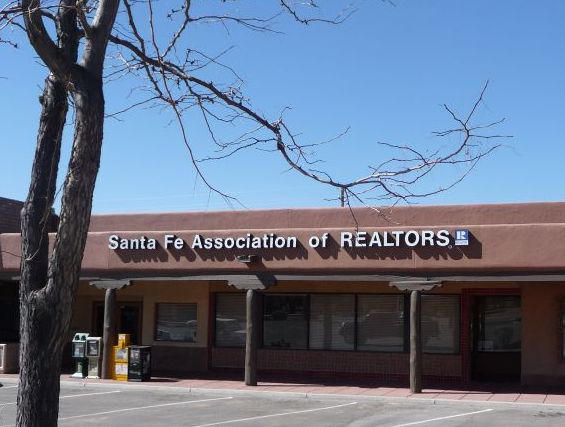
According to a 2006 report by the Federation of Tax Administrators, governments in 36 states, including the District of Columbia, impose transfer taxes on the sale of real estate, ranging from .01 percent in Colorado to 4 percent in parts of Pennsylvania. The tax is levied by the state, local governments, or a combination of the two. In almost every case the tax is calculated on the full sales price of the property. For a $750,000 house, the tax in the state of Washington, with a combined state and local rate of 1.33 percent, would be $9,975. In Pennsylvania it could run as high as $30,000.
Taxes on the sale of real estate are not a Communist conspiracy (as one local realtor actually said). They are a common way for governments to raise the money they need to operate.
You would never know that from the hysterical campaign waged by the Santa Fe Association of Realtors against the city's plan to raise money for affordable housing with a 1 percent surcharge on the portion of any real estate transaction exceeding $750,000. For an $800,000 house the buyer would pay an additional $500. (The realtors' commission would be $48,000.) For any transaction of $750,000 or less, the surcharge would be zero.

We've noted here before the dishonest tactics used by the realty association's cynically named front group, the Santa Fe Housing Opportunity Partnership. (Please see my post of October 7, 2007.) This week just about everyone in Santa Fe with a mailbox got three tracts carefully crafted to inflame and mislead: Politicians Want to Tax Your Home. . . Stop the Home Tax Now. Anyone who hasn't followed the issue could easily get the false impression that the city intends to tax every single homeowner in Santa Fe on a regular basis from now on.
The realtors go on to claim that if the tax is approved by voters, the City Council would have the power to expand it at will, making it more burdensome. Under state law that would be impossible without holding another special election.
Just as absurd is the group's claim that there is nothing to keep the Council from using the proceeds for purposes other than affordable housing. The ordinance, which can be downloaded here, could hardly be more specific:
All funds received by the city of Santa Fe pursuant to this Article shall be deposited into the Affordable Housing Trust Fund to be used only for the following types of affordable housing projects or programs provided that the assistance is related to workforce housing initiatives. The funds shall be subject to appropriation by the governing body of the city of Santa Fe, or its designee, only to the extent permitted by state law for the purpose(s) of: (1) Supporting workforce housing initiatives, including: providing matching funds to be used for down payment assistance; (2) Acquiring vacant land for affordable workforce housing; (3) Acquiring buildings for the purpose of affordable workforce housing; (4) Constructing or reconstructing housing for the workforce; (5) Maintaining and rehabilitating affordable housing; (6) Operating employer housing projects; and (7) Paying principal and interest on the bonds issued for affordable workforce housing purposes and incidental costs of issuing the bonds and the funding of any reserve.
You have to be pretty smart and good with numbers to maintain a New Mexico real estate license. At least some Santa Fe realtors must be embarrassed that their own association is making them look like ignorant yahoos.
Supporters of the tax, which include the New Mexico Conference of Churches, the Coalition to End Homelessness, and the Santa Fe Living Wage Network, aren't wealthy enough to counter with a slick campaign of their own. There is a good chance that enough people will believe the realtors' lies to defeat this modest and much-needed proposal. If so, I hope the City Council comes back with a tax on the full price of all real estate sales, with the money coming entirely from the agents' commissions.
March 3, 2009
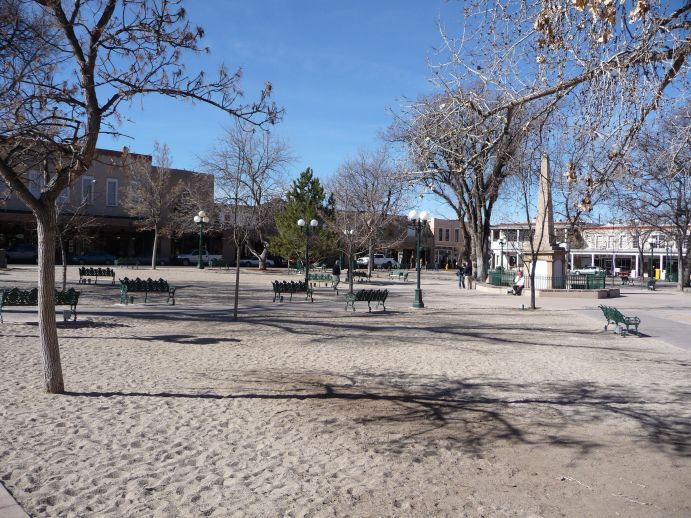
Sunday morning as I crossed the sandy expanse of the Santa Fe Plaza, I felt like I was walking on the beach. The ground was stripped bare during the extensive landscape renovations completed over the winter. Now some people are saying that the grass should not be replaced.
The controversy arose when Councilors Calvert and Bushee introduced a proposal to protect plaza vegetation by moving the booths for Indian Market, Spanish Market, and other annual foot-stomping events onto the pavement. The trampled grass is replaced every year, at a cost of thousands of dollars. But the compaction of the soil is also killing trees. The vendors' tents would still surround the Plaza periphery, and the overflow could be accommodated by closing off a few more downtown streets. With the additional open space, many more visitors could watch the bandstand events from the comfort of the lawn.
The backlash to this sensible proposition has been so extreme that the bill has been withdrawn, and Mr. Calvert has called for public hearings. In the meantime some local columnists and letter writers are saying that they would rather have the tents than the turf, that it is stupid to even have grass in this dry climate, that the Plaza should be covered with dirt or paved instead.
How sad that would be. In an op-ed piece in the New Mexican, Beverley Spears, the Santa Fe architect who designed the Plaza gazebo and collaborated on the new convention center, describes the importance of our tiny green oasis:
Of course, the grass requires heavy irrigation. But the effect of the green turf beneath the shade trees in the heart of town is worth every dollar and drop of water spent. In general, xeriscape landscaping is necessary and appropriate for nearly everywhere in Santa Fe, but the Plaza is an exception because of its relatively small size and its concentrated public use.
The grounds in front of the old library have already been ruined with an ugly zero-scape of gravel and plastic Easter basket grass. Huge swaths of the city hall lawn have been wiped out and replaced with islands of crunchy pecan shell mulch. If there is enough water for development and yet another new downtown hotel, then there should also be enough to maintain these old public spaces.
March 4, 2009
The junk mail from the realtors opposing the affordable-housing transfer tax keeps on coming, repeating the same misinformation. According to the campaign finance statements posted on the City Clerk's website, the cost of these mailings, by the Mack Crounse Group of Alexandria, Va., has been $55,164 so far. Another $32,914 has been paid to Hayduk-King Advertising of Santa Fe, and $30,000 to Carlos Trujillo of Chimayo as a "Grass Roots Coordinator Consultant Fee." (Funny how "grassroots" is mispelled in the same way it was by Santa Fe Grass Roots in the infamous 2004 City Council campaign. Probably just a coincidence.)
The money collected so far -- nearly $140,000 -- comes entirely from two organizations: about half from the Realtors Association of New Mexico and the rest from the National Association of Realtors.

March 5, 2009
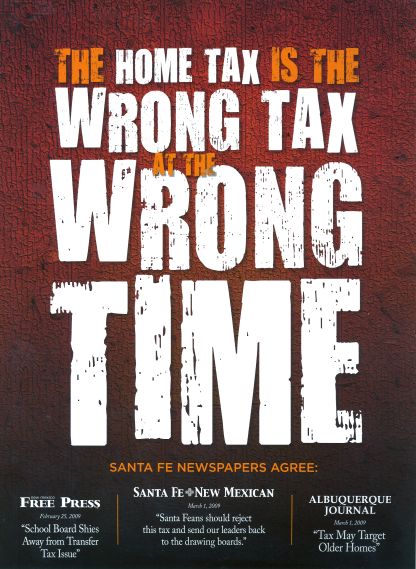
More propaganda against the affordable housing tax landed in the mailbox today, including the sleaziest flyer yet: The Home Tax is the Wrong Tax at the Wrong Time. Santa Fe Newspapers Agree.
Except that they don't. Though the New Mexican indeed opposed the tax in an editorial this week, the Journal has not taken a position. So the realtors made one up. The sentence they quote, "Tax May Target Older Homes," isn't from an editorial. It is a headline on a news story by reporter Kiera Hay. Written straight down the middle, the piece quotes the executive director of the Santa Fe Association of Realtors giving her opinion and Councilor Rebecca Wurzburger countering with a sharp rebuttal.
Again followers of the 2004 council campaigns might feel a sense of deja vu. Lifting words out of context to dishonestly imply that a local paper has officially endorsed your position was a tactic in Santa Fe Grass Roots' political smear jobs.
Realtors make a big deal about their Professional Code of Ethics. One section is called Duties to the Public:
REALTORS shall be honest and truthful in their real estate communications and shall present a true picture in their advertising, marketing, and other representations. . . .
I guess that only applies when they're selling houses. Otherwise all bets are off.
March 11, 2009
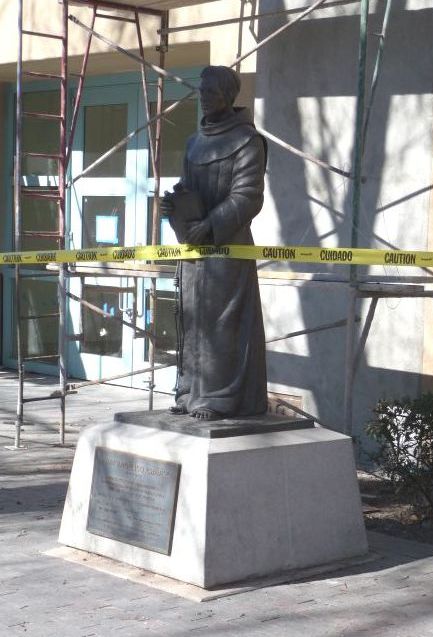
Baro Shalizi was gloating last night when he learned that he and his cohorts at the Santa Fe Association of Realtors had succeeded in defeating the real estate transfer tax. "I am very excited and really pleased to see that the citizens of Santa Fe understood the message that we put out," he told the New Mexican. Never mind that the message was a pack of lies. Reasonable people can disagree over whether a luxury tax on high-end real estate is the best way to raise money for affordable housing. They can ponder whether it is better to have an imperfect tax or none at all. Instead of engaging the community in intelligent debate, the realtors ran the most dishonest campaign this city has seen in five years. It may also turn out to be the most expensive -- $144,541.32 so far, with the final finance reports due on March 24.
There is no law against lying in a political campaign, and when the lies are amplified by big money from real estate PACs, the only hope for a fair election is with the press. Here both dailies feebly fulfilled their watchdog role. Reporters for the New Mexican and the Journal did a good job laying out the issues. But where were the campaign "report cards" that aggressive newspapers compile to evaluate the honesty of campaign literature? The Santa Fe Association of Realtors would have earned an F.
The dailies' editorial pages gave the realtors a mild slap on the wrist, and then went ahead and opposed the tax. The New Mexican depends on real estate advertising for its lifeblood, and Journal Santa Fe's editors apparently took their orders from Albuquerque.
Most dispiriting of all was how the vote split, right along St. Francis Drive. Districts 1 and 2, where most of the money is, opposed the tax 3 to 2. District 3 on the poorer Westside supported it by about the same margin, with middle-class District 4 breaking just about even.
"When you get outspent 10-to-1, it's hard to overcome that," Mayor Coss told the Journal. "It is what it is. These things are hard to do, especially in a special election." His words should have been harsher.
March 14, 2009
Simon Brackley, the president of the Santa Fe Chamber of Commerce, has written to object to my previous post, particularly this sentence: "Instead of engaging the community in intelligent debate, the realtors ran the most dishonest campaign this city has seen in five years."
In fact [he writes] the Realtors, Chamber, Homebuilders and others invited the City to participate in a community debate about workforce housing in June of 2008. The conversation to be facilitated by New Mexico First. The City refused to participate and insisted on moving ahead with the expensive and decisive ballot.
(Here is the full text of his email.)
The statesmanlike invitation he refers to came after the realtors and their allies had alienated just about everyone but themselves with another expensive advertising blitz -- the one where a "firefighter" and a "nurse" (paid models) pretended to oppose the affordable housing tax.
Another reader, Inez Russell, an editor and columnist at the New Mexican, was miffed by my implication that the newspaper sided with the realtors on the tax issue because of all the money it receives (or received) from real estate advertising:
I am very happy to work in a newsroom where the business concerns stay down the hall . . . You can agree or disagree with the editorial, but it was an honest opinion.
I didn't mean to suggest that there was anything like a quid pro quo. But it is harder to discount the possibility of a subtle influence. Any good newspaper has a firewall between the business and editorial departments. I'm glad to hear testimony that, in these troubled times, the barrier at the New Mexican remains intact.
Finally I heard from Asenath Kepler, former city manager and another opponent of the tax, who offered this suggestion for financing affordable housing:
Do an old-fashioned bond issue (if the city has any credit left) and propose something that leaves nothing to the imagination of voters, including realtors or anyone else. Affordable housing is a problem that should be shouldered by ALL of us homeowners, via property tax hikes. The city already has a lot of land and could put a lot of people to work if it unveiled a beautiful plan, tailored to the economic times, that created jobs, built green housing in viable communities, employed students, etc. -- all of which would have big public marketing potential.
It's a good idea, and one that has been suggested by the New Mexican and the Journal. But I'm finding it hard to be optimistic. The recent initiative failed because the realtors brainwashed a significant number of people into believing that the tax applied to them, not just to buyers of high-end property. Wouldn't the same voters be even less likely to support a tax that really did come from their own pockets?

A Special Report: The Mysterious Destruction of the Santa Fe Indian School

The Tom Ford Webcam (stolen July 7, 2008, back online July 17)
The Andrew and Sydney Davis Webcam
Who Owns the Plaza? (this may take a minute or so to load)
A Stroll Along Shirley Maclaine Boulevard
The Santa Fe Review
More links:
See the current flow of the Santa Fe River above McClure Reservoir with the USGS automated gauge.
The Otowi gauge shows the flow of the Rio Grande north of Santa Fe.
Santa Fe water information, a collection of documents and links